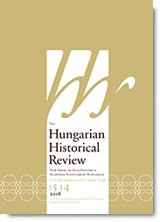Croatian Political Refugees Living in Emigration in the Interwar Period: The Case of the Croatian Political Refugees in Hungary
Croatian Political Refugees Living in Emigration in the Interwar Period: The Case of the Croatian Political Refugees in Hungary
Author(s): Petra HamerliSubject(s): Interwar Period (1920 - 1939)
Published by: Magyar Tudományos Akadémia Bölcsészettudományi Kutatóközpont Történettudományi Intézet
Keywords: Croatian refugees in Hungary; Jankapuszta; Ustaše
Summary/Abstract: After the disintegraton of the Austro-Hungarian Monarchy, the successor states also had to face the old problem of the “nationality question”. The Kingdom of Serbs, Croats and Slovenes (which in 1929 became the first incarnation of Yugoslavia) was the most multi-ethnic or multinational state in the region, and this led to conflicts, in particular between Serbs and Croats. When Alexander I introduced the dictatorship (January 6, 1929), many Croats decided to leave Yugoslavia. Most of them emigrated to Latin America, but Albania, Austria, Bulgaria, Germany, Hungary, and Italy, as neighboring states, were also popular directions. Many of the refugees left Yugoslavia for political reasons. Most of them emigrated to states that were interested in or actively sought the disintegration or at least weakening of Yugoslavia, such as Hungary and Italy, but many of them chose Austria, Belgium, and Germany. In this essay I focus primarily on the Croatian political refugees living in Hungary. The most important sources on these refugees are found in the Sate Archives of Italy (Archivio Centrale di Stato di Roma, ACS) in the material entitled “Carte Conti,” which includes the list of Croats for whom warrants had been issued and who were followed continuously by the Zagreb police and the Yugoslav authorities for political reasons. I also use primary sources to assess the role that the Croatian camp Jankapuszta, and the house in Nagykanizsa bought by the Ustaše leader Gustav Perčec played in the lives of migrants and in diplomatic calamities. In addition to the sources in the Sate Archives, I also draw on the documents of the Archives of the Italian Ministry of Foreign Affairs (Archivio Storico Diplomatico del Ministero degli Affari Esteri, ASMAE) and the National Archives of Hungary (Magyar Nemzeti Levéltár Országos Levéltára, MNL OL).
Journal: The Hungarian historical review : new series of Acta Historica Academiae Scientiarum Hungaricae
- Issue Year: 6/2017
- Issue No: 3
- Page Range: 624-646
- Page Count: 23
- Language: English

